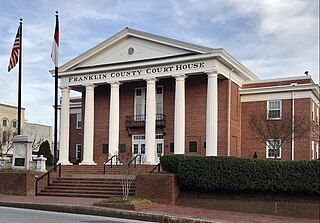
Franklin County is a county located in the U.S. state of North Carolina. As of the 2020 census, the population was 68,573. Its county seat is Louisburg.
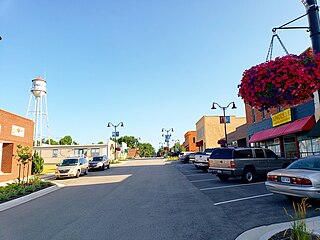
Louisburg is a city in Miami County, Kansas, United States. As of the 2020 census, the population of the city was 4,969.

Chocowinity is a town in Beaufort County, North Carolina, United States. The population was 820 at the 2010 Census. The town is a part of the Washington Area located in North Carolina's Coastal Plains region.
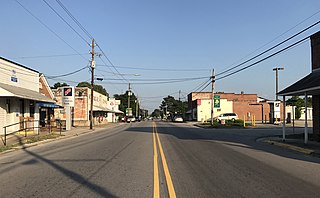
Bunn is a town in Franklin County, North Carolina, United States. The population was 327 at the 2020 census.

Centerville is a census-designated place (CDP) in the rural northeastern corner of Franklin County, North Carolina, United States. The population was 149 at the 2020 census. It was an incorporated town from 1965 to 2017.
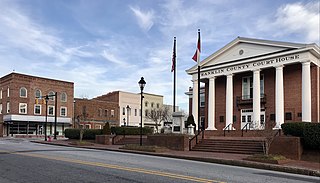
Louisburg is a town and the county seat of Franklin County, North Carolina, United States. As of the 2020 census, the town population was 3,064. The town is located approximately 29 miles northeast of the state capital, Raleigh, and located about 31 miles south of the Virginia border. It is also the home of Louisburg College, the oldest two-year coeducational college in the United States.
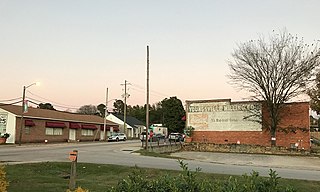
Youngsville is a town in Franklin County, North Carolina, United States. The population was 2,016 at the 2020 census.

Creedmoor is a city in Granville County, North Carolina, United States. The population was 4,124 at the 2010 census.
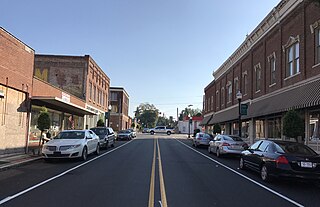
Weldon is a town in Halifax County, North Carolina, United States. The population was 1,655 at the 2010 census. It is part of the Roanoke Rapids, North Carolina Micropolitan Statistical Area.

Ahoskie is a town in Hertford County, North Carolina, United States. The population was 5,039 at the 2010 census. Ahoskie is located in North Carolina's Inner Banks region. Its nickname is "The Only One" because no other town in the world is known by the same name. The etymology of the word Ahoskie, which was originally spelled "Ahotsky", was from the Wyanoke Indians, who entered the Hertford County area at the beginning of European settlement.

Selma is a town in Johnston County, North Carolina, United States. In 2010, the population was 6,073, and as of 2018 the estimated population was 6,913. Selma is part of the Raleigh-Durham-Cary Combined Statistical Area. The area has a population over 1.7 million residents, though the town of Selma is able to maintain its rural character. The Everitt P. Stevens House, located in Selma, was the site of the last Grand Review of the Confederate Army held on April 6, 1865, after its defeat at the Battle of Bentonville.

Parmele is a town in Martin County, North Carolina, United States. The population was 278 at the 2010 census.

Star is a town in Montgomery County, North Carolina, United States. The population was 876 at the 2010 census.

Apex is a town in Wake County, North Carolina, United States. At its southern border, Apex encompasses the community of Friendship. In 1994, the downtown area was designated a historic district, and the Apex train depot, built in 1867, is designated a Wake County landmark. The depot location marks the highest point on the old Chatham Railroad, hence the town's name. The town motto is "The Peak of Good Living".
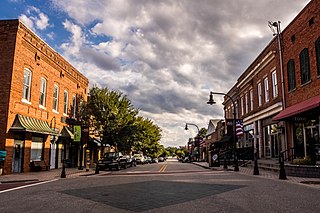
Wake Forest is a town in Franklin and Wake counties in the U.S. state of North Carolina; located almost entirely in Wake County, it lies just north of the state capital, Raleigh. At the 2020 census, the population was 47,601, up from 30,117 in 2010. It is part of the Raleigh metropolitan area. Wake Forest was the original home of Wake Forest University for 122 years before it moved to Winston-Salem in 1956.

The Research Triangle, or simply The Triangle, are both common nicknames for a metropolitan area in the Piedmont region of the U.S. state of North Carolina. Anchored by the cities of Raleigh and Durham and the town of Chapel Hill, the region is home to three major research universities: North Carolina State University, Duke University, and the University of North Carolina at Chapel Hill, respectively. The "Triangle" name originated in the 1950s with the creation of Research Triangle Park located between the three anchor cities, which is the largest research park in the United States and home to numerous high tech companies.
Franklin County Schools is a PK–12 graded school district serving Franklin County, North Carolina, United States. Its 16 schools serve 7,769 students as of the 2022–23 school year. The administrative offices are located in Louisburg.
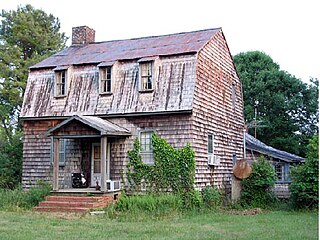
Shemuel Kearney House was a historic plantation house located near Franklinton, Franklin County, North Carolina, formerly at 2555 U.S. Highway 1 south of town. In 2009, the house was dismantled and moved to nearby Louisburg for restoration as the original property was recently zoned by Franklin County for commercial use. Therefore, the building had to be relocated. The Shemuel Kearney House was reconstructed next to another historic residence, the Cooke House, on Peach Orchard Road in 2015.
Cooke House is a historic plantation house located near Louisburg, Franklin County, North Carolina. The house was built about 1841, and consists of a two-story, three-bay, Greek Revival style frame main block with a smaller earlier one-story section. It has brick exterior end chimneys with stepped shoulders and a wide hip-roof front porch. It was built by Jonas Cooke (1786-1872), whose son Charles M. Cooke (1844-1920) was a noted North Carolina politician.

Person–McGhee Farm is a historic farm complex located at 5631 U.S. Highway 1 in Franklinton, Franklin County, North Carolina, about 4 miles north of town. The earliest section of the house was built sometime between 1770 and 1820, and is a three-bay, two-story frame dwelling over a stone-walled cellar. It has double shouldered brick end chimneys. In the 1890s, a large 2 1/2-story Queen Anne / Colonial Revival style section was added to the original Federal period dwelling. Also on the property are the contributing tenant house (1860s-1870s), a water tower, smokehouse, cattle barn, three log tobacco barns, and several sheds.



















